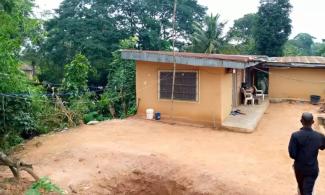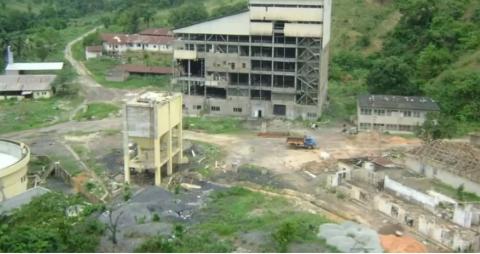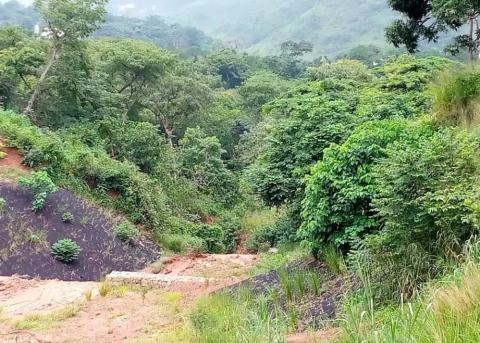
Communal efforts to reclaim their lands yielded little or no result, says John Enwu, a community leader.
Years of coal mining in some communities in Enugu State and attendant negligence of those mining sites are now leading to dangerous environmental degradation that threatens those communities. In this report, Ben Aroh, who visited Enugu North, Udi and Ezeagu local government areas of Enugu State where the mines are located, captures the fears of the residents and threats posed by the abandoned coal mines.

‘We are sandwiched by landslides’
Anthony Onoh and his family are marking time—their only home, sandwiched by abandoned mines, may sooner than later be swallowed by the mines. When it will happen is what they don’t know.
Onoh’s home is situated between Amuzam and Colliery, both at Ngwo in Enugu North Local Government Area, Southeast Nigeria, where the defunct Nigerian Coal Corporation (NCC) had mined coal. Coal mining in Enugu started in 1916, eight years after coal was discovered, and long before Nigeria made a discovery of crude oil in commercial quantity at Oloibiri in 1956 in the present-day Bayelsa State.
The house, Onoh says, is showing signs that its days are numbered, but he and his nuclear family has nowhere to relocate. “We live here because we don’t have options. We access our house through impassable routes. The foundation of our building is cracking and falling off. Surely, it will fall if nothing is urgently done to remedy the situation,” he said.
“By our right is the abandoned Colliery mine,” he continued. “Behind us is the Amuzam site. We can’t farm here anymore. There are no more sources of livelihood here. When we built this house, the gully was not spreading with this pace.”
Mercy, Anthony Onoh’s wife, says they see every day as the last for their house because the approaching erosion occasioned by the abandoned coal mines recently pulled down the perimetre fence of the house.
“A few days ago, the remaining part of our fence fell down,” Mercy Onoh said. “Our cries have not been listened to at all. Some property owners around here left many years ago because of the dangers therein. You wake up and see that a part of your house has collapsed.
“You can see that we are surrounded by gullies. Environmental officials have been coming. Some said they came from Abuja. But nothing much has been done. The Enugu State government is trying, but the speed this gully is spreading demands more action.”
Like Onoh’s family house, a worship centre, Rivers of Life Int. Mission Centre, sited near the Colliery landslide, is also waiting to be consumed by the threatening gully erosion. “The fear is that the gully is expanding daily without the corresponding intervention. If nothing is done urgently, this church may be pulled down. This is not our prayer,” says a member of the centre who identified himself as Nnamdi.
Coal mines abandoned after civil war
When it was discovered, Nigerian coal was exported to neighbouring Ghana, United Kingdom, Egypt and South Africa. But the production was crippled by the discovery of other sources of energy, Nigerian Civil War, and unsuccessful privatization attempts. “Nigeria Civil War negatively impacted on coal production,” the Nigerian Tourism Board was quoted in a report.

Following the war, production never completely recovered and coal production levels were erratic. Attempts at mechanizing production ended badly, as both the implementation and maintenance of imported mining equipment proved troublesome. It adversely affected production. After the civil war, the Nigerian coal industry has not been able to return to its peak production of the 1950s, the tourism board stated.
Several privatization attempts−to salvage the coal mining sector−including the one by former President Olusegun Obasanjo in 1999 up until 2004, did not bring back the fortunes of the once-flourishing industry. All these, including the selling-off of its assets by the NCC to settle debts owed its staff members, meant that the mines were forever abandoned.
The abandoned mines are now threatening human existence; and residents of the affected areas are helpless. “It is pathetic that we have been abandoned since coal became less fancied in this country,” Mr Onoh said. “My father told me that our area was a centre of attraction during the coal exploration. Thousands of people earned their living here.”

‘Flood washed away our relatives, homes before government’s interventions’
Amuzam, one of the abandoned coal mines, is littered with relics of collapsed buildings. Residents say the once-lively community could have gone into extinction because of the coal mines, but for the reclamation by the Enugu State government and the World Bank.
“You can see many collapsed storey-buildings. Some people also lost their lives. I recall a few that were swept by floods. Some of their corpses were never recovered. The outcry forced government’s intervention,” a resident, Paulinus Ossai, told our correspondent. He added that, “Without the reclamation done by the state government in collaboration with the World Bank, Amuzam would have gone into extinction.

“The construction company did a good job in filling the gullies. But many affected areas are yet to be covered.”
Communal efforts to reclaim their lands yielded little or no result, says John Enwu, a community leader. Their farmlands have equally been taken over by the environmental degradation that the abandoned coal mines have brought.
“Our farmlands and residential buildings were destroyed before this reclamation,” Enwu told our correspondent. “Another community which this ecological problem has adversely affected is Umueze-Asata, where farmlands have been washed away and getting very close to residential buildings.”
James Eze who lives in the same community shares his experience: “We tried all that we could. The erosion has gone beyond our local efforts. We dig holes just to slow down water pressures and water currents. We also fill bags of cement with sands just to hedge it off, but the water pressure is always too much.”
At Okpuno-Nsude in Udi Local Government Area where Okpara mines are located, residents live in constant fear during rainy seasons. Unlike Amuzam, the intervention at Okpuno-Nsude is still in the pipeline.
This hitherto agrarian community has become a ghost of itself as the landslides spread meteorically. The natives adopt various erosion-control measures to curtail it, but it keeps spreading. “We are worried that the underground tunnels that have been there for many years may cave in one day,” Sheddy Ozoene, a native of the village, said.
Titus Ozoani, another villager, corroborates Ozoene and said they live in fear. “We live in fear every day. Through communal efforts, we plant bamboo trees to ameliorate the situation. Although it curbs the excesses, a lot need to be done,” he told our reporter.

“There was a time the authorities of the World Bank came to supervise it. Ever since then, we have remained expectant. They are yet to return again. This erosion has killed our farming activities. The effect is devastating,” he said.
At the moment, the state government, under the Enugu State-Nigeria Erosion and Watershed Management Project (NEWMAP), a World Bank assisted project, is carrying out reclamation, channelling, and remediation at Colliery gully erosion site. It is being handled by Anbeez Services Ltd. The work at Amuzam gully site was also carried out by the same company.
Walking in the shadow of death
Seven communities under Agbaja cultural zone−Nsude, Obioma, Amuzam, Nachi, Eke, 9th Mile, and Ngwo−all with abandoned coal mines, have an undetermined and dangerous hollow beneath them.
Leaders of the areas, known as Agbaja Leaders of Thought, engaged the services of environmentalists and geologists. They say they were told that there are danger zones that could cave in like earthquake. They are demanding the mining maps to determine these red zones.
Agu Gab Agu, a professor of law and secretary of the group, says the mines were shut hurriedly without due processes. Agu blamed the Nigerian government for failing to do the right thing in reclaiming the affected areas at the time the coals were shut down.
“These mines were shut hurriedly without due processes,” he said. “Usually, when mines are being closed, there should be props or trees to hold the openings in the bowel of the earth. They are large openings that when they start to cave in, they will bring down everything on their top.
“The mines travel many kilometres, as far as Ebe, Obioma, and Nachi. So we are on top of them without knowing that the underneath is hollow. Some communities, like Nsude, will soon cave in.”
They are apprehensive of what could happen soon. So they are seeking to have the map of the area. “We have commissioned some work by environmentalists and geologists on that,” Agu says. “Our query is that those who did this thing should give us the maps. We want to know the danger zones.
“Nobody can discountenance that the problem of Ugwu Onyeama may be part of this development. If it passed through 9th Mile, with the ongoing development there, it means that one day, it will just go down. Most of those lands may not be useful to the owners again. They ought to be restituted.”
Nigerian Mining Act 2007, although does not specify the penalties for non-reclamation of mined areas, is explicit in ensuring standard practices at mine zones, particularly by those who worked on the mines.
Chapter Four of the Act, entitled ‘Environmental Considerations and Rights of Host Communities, states that, “The minister shall by order require the grantee of a mining lease to restore any area in respect of which mining operation has been, is being, or is to be carried out, on or after the date on which this Act comes into operation.
“Where land which is subject of a mining lease has been exploited, the reclamation of mined-out areas shall be restored by the applicant under the condition of its grant, otherwise the relevant provision of section 10 of this Act shall apply.”
Government Interventions
Barr Vincent Egechukwu Obetta, project coordinator of Enugu State-NEWMAP, revealed that, “The project intervention on the erosion areas in Ngwo communities has commenced with the award of contracts for the six sites.”
However, for that of Ugwuto-Nsude, the project was successfully handed over on October 2018, on completion, to the host community, Obetta further said.
Investigations by this newspaper show that intervention work is ongoing at four fingers of the abandoned mines located at Isata, Colliery, St Theresa’s and Amuzam, although at a snail’s pace.
This, according to findings, is a result of paucity of funds towards the counterpart funding scheme. “The reclamation of Amuzam and ongoing works at some other affected sites of the landslides show that Gov Ifeanyi Ugwuanyi has not forgotten these areas,” a local source who did not want to be named said.
A publication of Enugu State-Nigeria Erosion and Watershed Management Project shows that former governor Sullivan Chime paid a counterpart fund of N30 million and another N30 million in 2013, and later approved N200 million in 2014 for NEWMAP projects as counterpart funds with the World Bank.
– This story was produced in partnership with Civic Media Lab under its Grassroots News Project